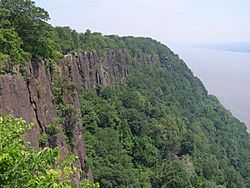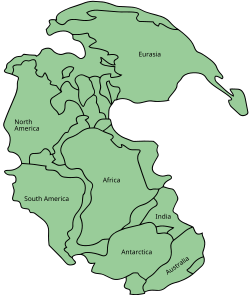Pangaea facts for kids


Pangaea was the global supercontinent which formed in the Palaeozoic era. The process started about 450 million years ago (mya), and was complete by 210 mya.
Pangea was the latest of a series of global supercontinents. They formed at various times since plate tectonics began on Earth.
Formation
The collisions between continental plates formed the greatest mountain ranges in the history of the Phanerozoic eon. The mountain building included the Caledonian orogeny and the Alleghenian orogeny. The low mountains of Scotland, Scandinavia and eastern North America are the ground-down remains of these vast events.
Break-up
There were three major phases in the break-up of Pangaea. Actually, the first signs of rifting came in the Triassic before Pangaea was completely formed.
Pangaea broke up about 180/200 million years ago, in the early middle Jurassic. It broke into supercontinents Laurasia and Gondwana before each of these broke into the current continents. One rift resulted in a new ocean, the North Atlantic Ocean.
The second major phase in the break-up of Pangaea began in the Lower Cretaceous (150–140 Ma), when Gondwana separated into multiple continents (Africa, South America, India, Antarctica, and Australia).
The third major and final phase of the break-up of Pangaea occurred in the early Cenozoic (Paleocene to Oligocene). Laurasia split when North America/Greenland (also called Laurentia) broke free from Eurasia, opening the Norwegian Sea about 60–55 Ma. The Atlantic and Indian Oceans continued to expand, closing the Tethys Ocean.
The break-up of Pangaea continues today in the Great Rift Valley in East Africa and Arabia.
Other sources
- Matte P. 2001. The Variscan collage and orogeny (480-290 Ma) and the tectonic definition of the Armorica microplate: a review. Terra Nova 13, 122-128.
- Stampfli G.M.; Raumer J.F. von & Borel G.D. 2002. Paleozoic evolution of pre-Variscan terranes: from Gondwana to the Variscan collision. Geological Society of America Special Paper 364, pp. 263-280.
- Torsvik T.H.; Smethurst M.A.; Meert J.G.; Van der Voo R.; McKerrow W.S.; Brasier M.D.; Sturt B.A. & Walderhaug H.J. 1996. Continental break-up and collision in the Neoproterozoic and Palaeozoic - a tale of Baltica and Laurentia. Earth-Science Reviews 40, pp. 229-258.
Images for kids
-
The supercontinent Pangaea in the early Mesozoic (at 200 Ma)
See also
 In Spanish: Pangea para niños
In Spanish: Pangea para niños









